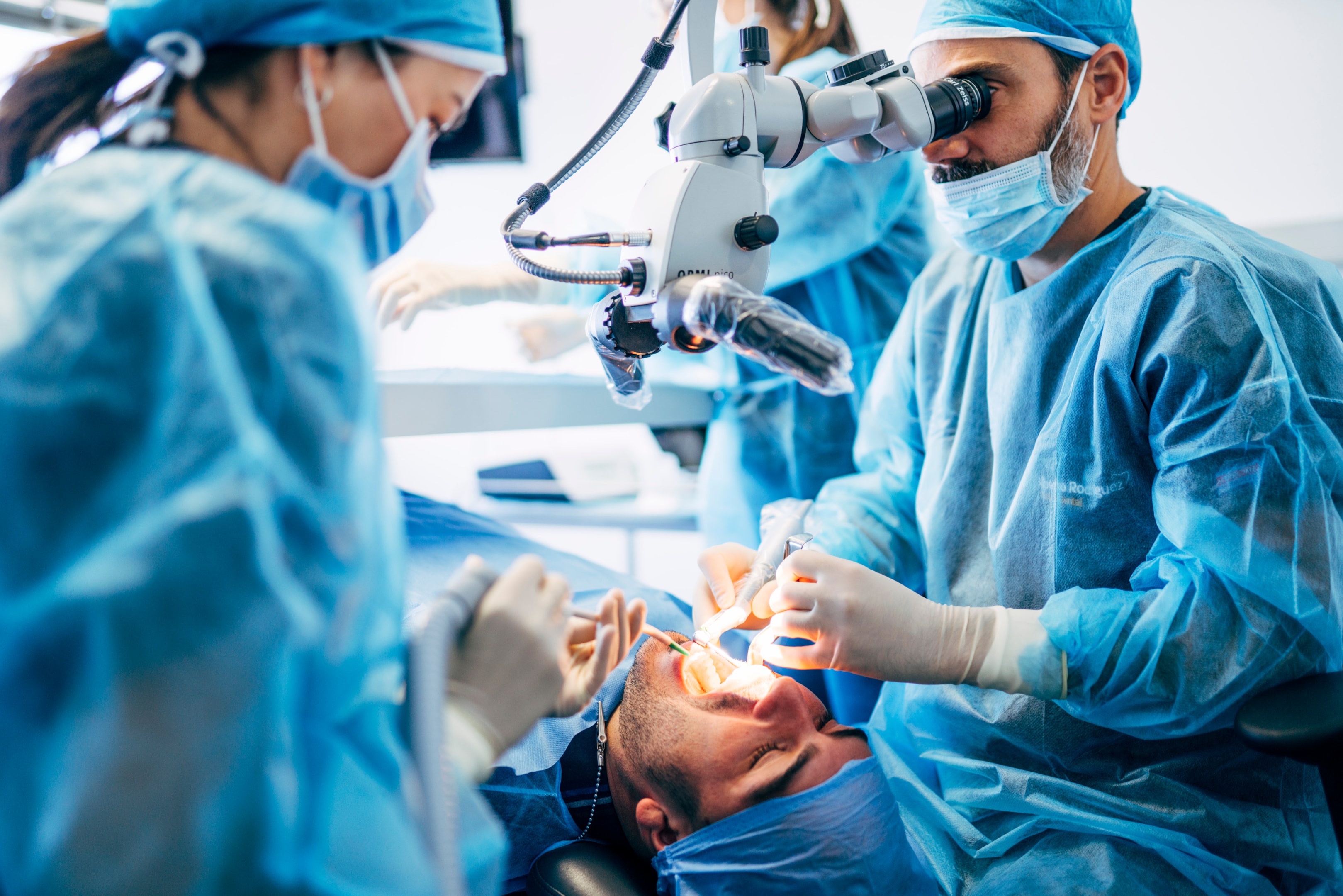
When it comes to maintaining that perfect smile, bone health in the jaw often doesn’t get the spotlight it deserves.
Most people know about fillings, crowns, and maybe even dental implants, but fewer are familiar with the critical role bone grafts play in oral health.
At South Calgary Oral Surgery, we specialize in procedures like bone grafting to ensure the foundation of your mouth remains as robust as possible.
Just like a house needs a strong foundation to stand tall, your mouth needs a solid jawbone to support your teeth.
Unfortunately, bone loss can happen for several reasons, leaving you with an unstable foundation.
This is where bone grafts come into play, providing a much-needed boost to your oral health and paving the way for future dental work.
In this blog post, we’ll explore the ins and outs of bone grafts for the mouth, the role of an oral surgeon, and why this procedure might be right for you.
Why Are Bone Grafts Needed?
Understanding the Foundations: What Causes Bone Loss?
Imagine trying to build a castle on sand. Without a firm foundation, everything you build on top is unstable.
Similarly, when there is bone loss in your jaw, it can cause instability for your teeth and dental implants due to the weakened jaw bone.
Bone loss can occur due to several reasons:
Tooth Loss: Missing teeth, especially if not replaced promptly, can lead to bone deterioration in the jaw.
Periodontal Disease: Severe gum infections can damage the bone around your teeth, causing it to recede.
Trauma or Injury: Accidents or injuries to the face can result in bone loss.
Developmental Defects: Some individuals are born with defects that affect bone growth in the jaw.
Bone grafts for the mouth are essential in these cases to rebuild the bone structure and prepare the mouth for future dental procedures, such as implants.
How Bone Grafts Work
Bone grafting involves using various bone graft materials, such as bone from another part of your body or synthetic options, to repair and rebuild the jawbone.
This creates a stable base for dental implants, crowns, or dentures. Think of it as patching up a road to make it smooth and safe for driving.
The bone graft fills in the gaps and encourages new bone growth, essentially providing a clean slate for your oral health.
Practical Tip: Always consult with an oral surgeon, like our experienced team at South Calgary Oral Surgery, to understand the specifics of why a bone graft might be needed in your situation.
The Benefits of Bone Grafts for Mouth Health

Bone grafts are essential in dental procedures to ensure the stability and success of implants. They provide a scaffold for new bone growth, which is crucial for maintaining the structure and function of the jawbone.
By using graft materials, especially autografts from the patient’s own body, the healing process is enhanced, leading to faster recovery. This promotes new bone formation, which is vital for the success of subsequent dental procedures like implants.
Reinforcing the Foundation: Why Bone Grafts Are Good
A bone graft can be a game-changer for your dental health.
Not only does it prepare your jaw for further dental work, but it also:
Prevents Further Bone Loss: By stimulating bone growth, bone grafts can prevent further deterioration of the jawbone.
Improves Aesthetic Appearance: A healthy jawbone supports facial structure, preventing a sunken appearance that can result from bone loss.
Enhances Oral Function: A strong jawbone allows for better chewing and speaking abilities, which are crucial for daily life.
“Bone grafting is like reinforcing the roots of a tree,” says Dr. Brad Fisher, an oral surgeon. “Without strong roots, the tree can’t thrive, and similarly, without a healthy jawbone, your teeth can’t function properly.”
How Bone Grafts Enhance Future Dental Work
If you’re considering a dental implant or other major dental work, a bone graft may be necessary.
The graft creates a solid foundation, increasing the chances of success for these procedures.
It’s a bit like laying the groundwork before constructing a building – it’s a necessary step to ensure everything stays in place for the long term.
Practical Tip: Discuss with your oral surgeon if bone grafting is needed before getting dental implants. This foresight can save you time, money, and discomfort in the future.
The Role of the Oral Surgeon in Bone Grafting
Expertise Matters: Trusting the Professionals
Bone grafting isn’t a DIY project. It requires the expertise of a skilled oral surgeon to assess, plan, and execute the procedure.
At South Calgary Oral Surgery, our team of experts ensures that each bone graft is tailored to the patient’s specific needs.
We use state-of-the-art technology to assess bone density and health, ensuring the best possible outcome.
“Choosing an experienced oral surgeon is crucial for the success of bone grafting procedures,” explains Dr. Miller Smith, an oral surgeon at our practice. “Not all cases are the same, and a tailored approach ensures better integration and healing of the graft.”
Steps in the Bone Grafting Process
Consultation and Imaging: Before any procedure, a thorough consultation and imaging (such as X-rays or CT scans) are necessary to evaluate bone health.
Surgical Procedure: During bone grafting surgery, the graft material is placed in the area needing reinforcement. This can be bone from another area of the patient’s body, a donor, or synthetic bone.
Recovery and Monitoring: After the procedure, there is a healing period where the bone integrates with the graft material. Regular follow-up visits are essential to monitor progress.
Practical Tip: Ask your oral surgeon about the different types of graft materials available and which one is best suited for your needs.
Pros and Cons of Bone Grafting

Dental bone grafting is a surgical procedure essential for regenerating and replacing lost bone, often necessitated by tooth loss or gum disease. This process provides a solid foundation for dental implants, which is crucial for maintaining jaw integrity and overall dental health. However, like any surgical procedure, it comes with its own set of risks and recovery expectations. Understanding both the benefits and potential complications can help patients make informed decisions about their dental care.
Weighing the Benefits and Drawbacks
Like any surgical procedure, bone grafting has its pros and cons. Understanding these can help you make an informed decision.
Pros:
Restores Bone Density: Essential for those who have lost bone mass due to missing teeth or gum disease.
Supports Future Dental Work: A necessary step for implants and other restorative procedures.
Improves Oral Health: Can prevent further bone loss and maintain facial structure.
Cons:
Surgical Risks: Like any surgery, there are risks, including infection, nerve damage, or graft rejection.
Cost: Bone grafting can be expensive, depending on the type of graft and the extent of the procedure.
Recovery Time: There is a healing period that can vary depending on the individual’s health and the extent of the graft.
Practical Tip: Always discuss the risks and benefits with your oral surgeon to ensure you are fully informed before proceeding with a bone graft.
How to Prepare for a Bone Graft for Mouth
Steps to Ensure a Smooth Procedure
Preparation is key to a successful bone graft. Here are some steps to take:
Follow Pre-Surgery Instructions: Your oral surgeon will provide instructions regarding diet, medication, and oral hygiene before the procedure.
Arrange for a Ride: You may need someone to drive you home after the procedure, especially if sedation is used.
Plan for Recovery: Set up a comfortable space at home for recovery, and stock up on soft foods and any prescribed medications.
Practical Tip: Don’t hesitate to ask your oral surgeon any questions you have before the procedure. Being prepared can reduce anxiety and ensure a smoother experience.
The Healing Process: What to Expect After a Bone Graft

Once a bone graft heals, it is crucial to follow up with a dental implant within a limited timeframe to prevent loss of density and shrinkage of the graft.
Patience and Care: Your Role in Recovery
The healing process after a bone graft for the mouth can take several months. During this time, new bone cells will grow around the graft, solidifying the area.
It’s crucial to follow your oral surgeon’s post-operative care instructions carefully.
Maintain Good Oral Hygiene: Keep the area clean to prevent infection, but be gentle to avoid disturbing the graft.
Diet Adjustments: Stick to soft foods and avoid chewing on the side of the graft for the first few weeks.
Avoid Smoking: Smoking can significantly delay healing and increase the risk of complications.
“Patience during recovery is vital,” says Dr. Simon Touchan, a seasoned oral surgeon. “Your body needs time to heal, and following post-op care instructions will ensure the best outcome.”
Practical Tip: Regular follow-ups with your oral surgeon are essential to monitor healing and address any issues that may arise.
FAQs About Bone Graft for Mouth
Addressing Common Concerns and Questions
Is Bone Grafting Painful?
The procedure is performed under anesthesia, so you shouldn’t feel pain during surgery. Post-surgery discomfort is manageable with prescribed pain relievers.
How Long Does the Graft Take to Heal?
Healing times vary but generally take 3-6 months for the bone to fully integrate.
Are Bone Grafts Always Successful?
Most bone grafts are successful, especially when done by experienced oral surgeons. However, factors like overall health, oral hygiene, and smoking can affect the outcome.
Practical Tip: If you have specific concerns about bone grafting, book a consultation with one of our oral surgeons at South Calgary Oral Surgery to discuss your options and what to expect.
Conclusion

Bone grafting for the mouth is a vital procedure for many individuals looking to restore their dental health and ensure the longevity of future dental work.
At South Calgary Oral Surgery, we understand that every patient is unique, and our team of skilled oral surgeons is here to provide personalized care tailored to your needs.
Whether you’re dealing with bone loss due to missing teeth, periodontal disease, or trauma, a bone graft could be the solution to rebuild your foundation and restore your smile.
Remember, a strong foundation leads to a beautiful smile and better oral health.
Don’t let bone loss hold you back—schedule a consultation with us today to learn more about bone grafts for the mouth and how we can help you achieve the smile of your dreams.






